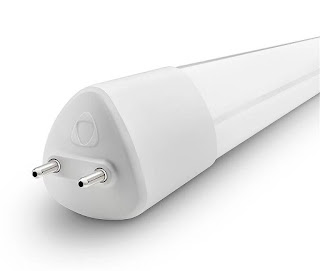 An RF-Quiet LED ‘Fluorescent’ Bulb
An RF-Quiet LED ‘Fluorescent’ Bulb
I recently had the fluorescent bulb in one section of the under-cabinet kitchen counter lighting fixture go dark. This wasn’t too surprising as the 24” bulb had been in place since the house was built in 1990!
 |
Steve McDonald, VE7SL, is a regular contributor to AmateurRadio.com and writes from British Columbia, Canada. Contact him at [email protected].
 Why People Hate FT8
Why People Hate FT8
Let’s just be real for a moment. A lot of people hate FT8. You all have seen it in social media and on the air. It’s a popular mode, so popular in fact that one report citing Club Log data recently showed that 80% of HF contacts in their tracking nowadays are FT8. This increase has come at the expense of other mode activity, especially CW. What’s worse in the minds of some, is that accomplishments like DXCC which used to take several to many years to reach is being significantly shortened with the use of FT8.
I’ve often thought it’s a fait accompli achieving DXCC, one just needs to sit in a chair long enough. FT8 has given a means to bypass a lot of that chair-sitting. I think FT8 just exposed an inconvenient truth that there really wasn’t a whole lot of skill involved in DXCC. Skill may lessen the amount of time it takes. FT8 just automated the process and significantly reduced the time needed and totally removed any skill advantage.
FT8 or another similar mode was going to happen sometime. It’s like the concept of steam engine time. The idea or theory is that the steam engine would have been invented at probably the same time in history by anyone or several people simultaneously in the world, even if many inventors were isolated and not in contact with each other. It was just bound to happen at some point given the progression of technology and the availability of materials and know-how to do it. We all knew (well, those of us with engineering know-how) that a semi-synchronous extremely low baud rate, low signal-to-noise ratio mode would work and be quite robust. It’s Shannon’s Theorem applied. What is at issue is the way Joe Taylor packaged it. We could do great things with low baud rate/low S/N modes. How about a TCP/IP link to a BBS on the moon or an open global resilient messaging network that works on every band in the lowest of the low sunspot cycles? Instead, it was packaged as a low effort point-and-click QSO slot machine, unable to convey anything intelligent.
There are fully automated FT8 stations out there where the operator just clicks a button and the station makes contacts all day. We all know it, we just don’t know the extent of it. This I think is the crux of the problem. FT8 has become something akin to Bitcoin-mining, but it’s QSO-mining, and FT8 with automation which is undoubtedly happening has devolved pursuit of accomplishments into a virtual QSO Battlebots competition.
Personally, I’ve become indifferent to the whole FT8 debate, and frankly anything that involves DXing, DXCC, contesting, or collecting wallpaper. I don’t hate FT8, but I get the discontent about it that is expressed in amateur radio circles. I have always been one to tell others to not be mode bigots, or put down other modes. The FT8 mode itself is not bad technology, or detrimental to amateur radio. The mindless fashion in which it is in use I’m not so sure about.
This article was originally posted on Radio Artisan.
Anthony, K3NG, is a regular contributor to AmateurRadio.com.
 Why People Hate FT8
Why People Hate FT8
Let’s just be real for a moment. A lot of people hate FT8. You all have seen it in social media and on the air. It’s a popular mode, so popular in fact that one report citing Club Log data recently showed that 80% of HF contacts in their tracking nowadays are FT8. This increase has come at the expense of other mode activity, especially CW. What’s worse in the minds of some, is that accomplishments like DXCC which used to take several to many years to reach is being significantly shortened with the use of FT8.
I’ve often thought it’s a fait accompli achieving DXCC, one just needs to sit in a chair long enough. FT8 has given a means to bypass a lot of that chair-sitting. I think FT8 just exposed an inconvenient truth that there really wasn’t a whole lot of skill involved in DXCC. Skill may lessen the amount of time it takes. FT8 just automated the process and significantly reduced the time needed and totally removed any skill advantage.
FT8 or another similar mode was going to happen sometime. It’s like the concept of steam engine time. The idea or theory is that the steam engine would have been invented at probably the same time in history by anyone or several people simultaneously in the world, even if many inventors were isolated and not in contact with each other. It was just bound to happen at some point given the progression of technology and the availability of materials and know-how to do it. We all knew (well, those of us with engineering know-how) that a semi-synchronous extremely low baud rate, low signal-to-noise ratio mode would work and be quite robust. It’s Shannon’s Theorem applied. What is at issue is the way Joe Taylor packaged it. We could do great things with low baud rate/low S/N modes. How about a TCP/IP link to a BBS on the moon or an open global resilient messaging network that works on every band in the lowest of the low sunspot cycles? Instead, it was packaged as a low effort point-and-click QSO slot machine, unable to convey anything intelligent.
There are fully automated FT8 stations out there where the operator just clicks a button and the station makes contacts all day. We all know it, we just don’t know the extent of it. This I think is the crux of the problem. FT8 has become something akin to Bitcoin-mining, but it’s QSO-mining, and FT8 with automation which is undoubtedly happening has devolved pursuit of accomplishments into a virtual QSO Battlebots competition.
Personally, I’ve become indifferent to the whole FT8 debate, and frankly anything that involves DXing, DXCC, contesting, or collecting wallpaper. I don’t hate FT8, but I get the discontent about it that is expressed in amateur radio circles. I have always been one to tell others to not be mode bigots, or put down other modes. The FT8 mode itself is not bad technology, or detrimental to amateur radio. The mindless fashion in which it is in use I’m not so sure about.
This article was originally posted on Radio Artisan.
Anthony, K3NG, is a regular contributor to AmateurRadio.com.
 You just never know………
You just never know………
 |
| 9K2OW in the log |
This evening I decided to settle into the shack and once again get on FT8 to see what was happening. I went directly to 40m and set my power to 70 watts. As a side note funny thing about 40m I used to bother the washer machine and an office light would turn on and off but for some reason not anymore. Anyway, this post was about a very nice FT8 contact I made. I was calling CQ well to be more accurate my computer was calling CQ. Right out of the blue I had a call from 9K2OW in Kuwait!!
With a couple of mouse clicks and he was in the log. Recently I have been reading some positive and negative opinions regarding FT8. Personally, I like to stay neutral when I read these posts maybe that is the Canadian in me but I do know I had a blast having Kuwait answer my CQ call on 40m. It was a short but good evening on ham radio!
Mike Weir, VE9KK, is a regular contributor to AmateurRadio.com and writes from New Brunswick, Canada. Contact him at [email protected].
 LHS Episode #405: It Lives
LHS Episode #405: It Lives
Hello and welcome to the 405th installment of Linux in the Ham Shack. In this episode, the hosts discuss the zombie apocalypse--well, almost. Topics range from World Amateur Radio Day to the return of RMS to the cancellation of big amateur radio events around the world. There's also a new edition of Deepin and AlmaLinux, available funding for open source projects and much more. We hope you enjoy this episode and as always, thanks for listening.
73 de The LHS Crew
Russ Woodman, K5TUX, co-hosts the Linux in the Ham Shack podcast which is available for download in both MP3 and OGG audio format. Contact him at [email protected].
 AmateurLogic Shorts 2: MotionEyeOS
AmateurLogic Shorts 2: MotionEyeOS
In the new AmateurLogic Shorts episode 2 Mike shares a great Pi project. MotionEyeOS turns your Raspberry Pi and camera into a motion tracking device.
Please Subscribe and click the Like and Share buttons if you enjoy our content.
Note AmateurLogic Shorts are only available on YouTube.
George Thomas, W5JDX, is co-host of AmateurLogic.TV, an original amateur radio video program hosted by George Thomas (W5JDX), Tommy Martin (N5ZNO), Peter Berrett (VK3PB), and Emile Diodene (KE5QKR). Contact him at [email protected].
 LHS Episode #404: The Weekender LXIX
LHS Episode #404: The Weekender LXIX
It's time once again for The Weekender. This is our bi-weekly departure into the world of amateur radio contests, open source conventions, special events, listener challenges, hedonism and just plain fun. Thanks for listening and, if you happen to get a chance, feel free to call us or e-mail and send us some feedback. Tell us how we're doing. We'd love to hear from you.
73 de The LHS Crew
Russ Woodman, K5TUX, co-hosts the Linux in the Ham Shack podcast which is available for download in both MP3 and OGG audio format. Contact him at [email protected].

















